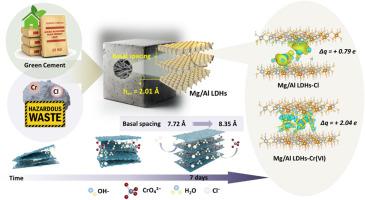铬酸盐和氯化物插层Mg/Al层状氢氧化物在低碳水泥中的重构动力学和结构演化
IF 13.1
1区 工程技术
Q1 CONSTRUCTION & BUILDING TECHNOLOGY
引用次数: 0
摘要
了解Mg/Al层状双氢氧化物(LDH)的早期重建对于增强低碳胶凝体系中的阴离子固定化至关重要。在此,我们结合原位和非原位同步加速器x射线衍射分析,揭示了在富含Cr(VI)和Cl -的胶凝环境中,煅烧Mg/Al-LDH (CLDH)转化成Mg/Al-LDH的时间依赖性和可逆层状结构转变。结果表明,Mg/ al -LDH的初始层间空间为7.64 ~ 7.74 Å,是OH -插层LDH的典型结构,而Cr(VI)阻碍了LDH的重建。Cl -和Cr(VI)阴离子的插入使Mg/Al-LDHs的层间空间扩大到8.35 Å,但对片层骨架的影响可以忽略。密度泛函理论计算表明,Cr(VI)比Cl -对Mg/Al-LDH层具有更强的亲和力,表现为更高的电荷转移(+2.04 e比+0.79 e)和更低的层间吸附能(-1.92 eV比-0.29 eV)。通过选择Cr(VI)和Cl -这两种不同电荷和几何形状的危险废物中共存的阴离子,我们获得了对更广泛的氧阴离子群(例如SO42-, AsO43-)在含ldh的低碳水泥中的行为的机制理解。实时观察和理论计算揭示了低碳水泥中Mg/Al-LDH的阴离子驱动重构,指导了低碳水泥中有害阴离子固定化的ldh改性低碳水泥的开发。这些发现促进了可持续胶凝材料在各种恶劣环境中的广泛采用。本文章由计算机程序翻译,如有差异,请以英文原文为准。


Reconstruction kinetics and structural evolutions of chromate and chloride intercalated Mg/Al layered double hydroxide in low-carbon cements
Understanding the early-stage reconstruction of Mg/Al layered double hydroxide (LDH) is critical for enhancing anion immobilization in low-carbon cementitious systems. Here, we combined in-situ and ex-situ synchrotron X-ray diffraction analyses to reveal the time-dependent and reversible layered structure transformation of Mg/Al-LDH from calcined Mg/Al-LDH (CLDH) in cementitious environments enriched with Cr(VI) and Cl−. Our observations revealed that the initial interlayer space of Mg/Al-LDHs ranged from 7.64 to 7.74 Å, typical for OH− intercalated LDHs, while Cr(VI) hindered the LDH reconstruction. Intercalation of Cl− and Cr(VI) anions expanded the interlayer space of Mg/Al-LDHs up to 8.35 Å, yet had a negligible impact on the lamellar skeleton. Density functional theory calculations indicated that Cr(VI) had a stronger affinity for Mg/Al-LDH layers than Cl−, evidenced by higher charge transfer (+2.04 e vs. +0.79 e) and lower interlayer adsorption energy (−1.92 eV vs. −0.29 eV). By selecting Cr(VI) and Cl–, two coexisting anions in hazardous wastes with different charges and geometry, we gained a mechanistic understanding of how a broader group of oxyanions (e.g., SO42−, AsO43−) behave in LDH-containing low-carbon cements. Real-time observation and theoretical calculations unveiled the anion-driven reconstruction of Mg/Al-LDH in low-carbon cement, guiding the development of LDH-modified low-carbon cement for immobilizing harmful anions in aggressive environments. These findings facilitated the broader adoption of sustainable cementitious materials across various aggressive environments.
求助全文
通过发布文献求助,成功后即可免费获取论文全文。
去求助
来源期刊

Cement & concrete composites
工程技术-材料科学:复合
CiteScore
18.70
自引率
11.40%
发文量
459
审稿时长
65 days
期刊介绍:
Cement & concrete composites focuses on advancements in cement-concrete composite technology and the production, use, and performance of cement-based construction materials. It covers a wide range of materials, including fiber-reinforced composites, polymer composites, ferrocement, and those incorporating special aggregates or waste materials. Major themes include microstructure, material properties, testing, durability, mechanics, modeling, design, fabrication, and practical applications. The journal welcomes papers on structural behavior, field studies, repair and maintenance, serviceability, and sustainability. It aims to enhance understanding, provide a platform for unconventional materials, promote low-cost energy-saving materials, and bridge the gap between materials science, engineering, and construction. Special issues on emerging topics are also published to encourage collaboration between materials scientists, engineers, designers, and fabricators.
 求助内容:
求助内容: 应助结果提醒方式:
应助结果提醒方式:


